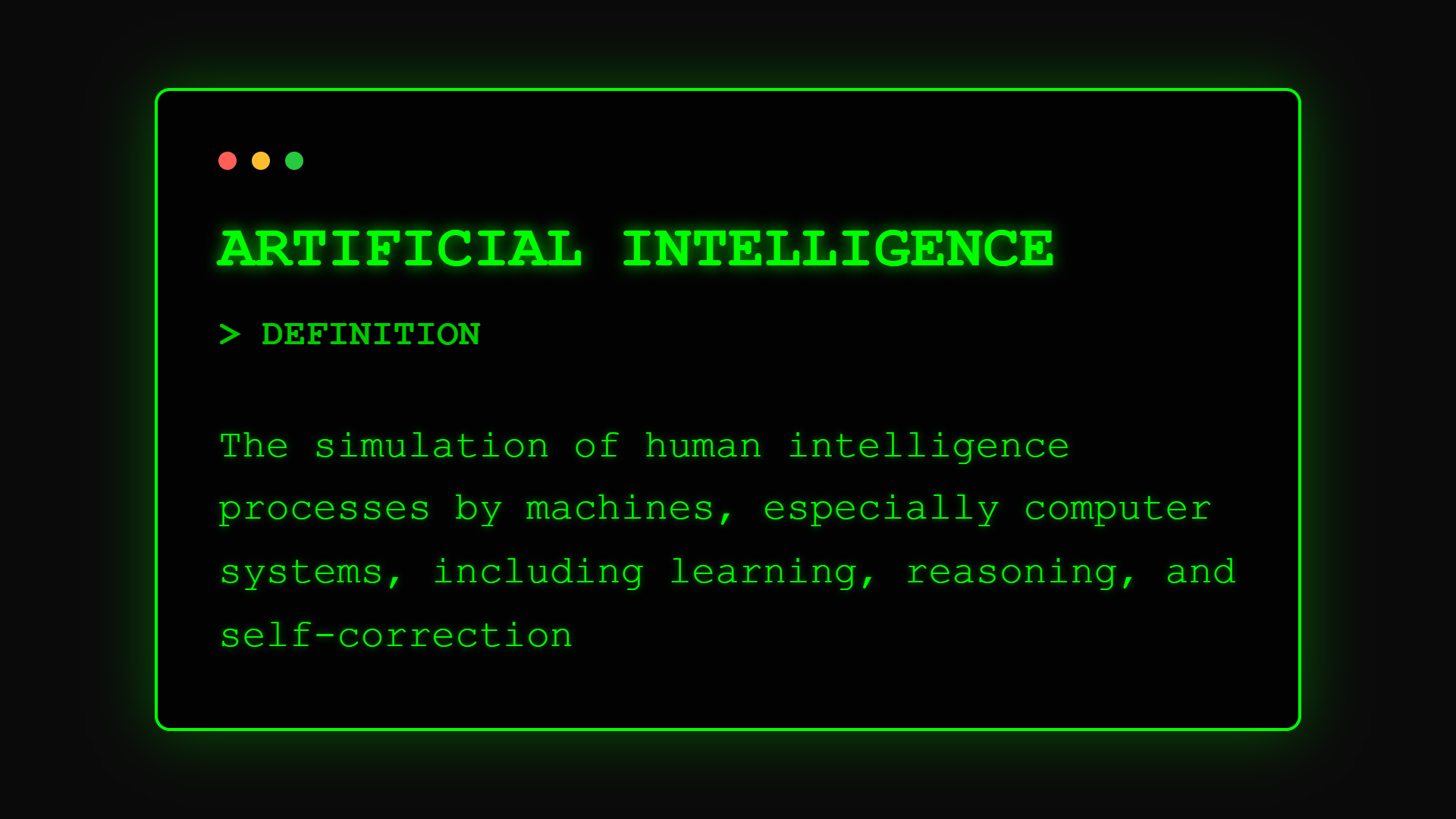AI Terms
What is Artificial Intelligence? When Machines Think for Business

Your competitors are making millions of decisions per second, learning from each one, and getting smarter every day. They're not hiring more people. They're using artificial intelligence. But what exactly is this technology that's reshaping entire industries?
The Academic Foundation
The term "artificial intelligence" was coined at the 1956 Dartmouth Conference by computer scientist John McCarthy, who defined it as "the science and engineering of making intelligent machines." The original proposal outlined an ambitious goal: to describe every aspect of human intelligence so precisely that a machine could simulate it.
According to modern computer science, AI is defined as "systems that perceive their environment and take actions to maximize their chance of achieving specific goals" (Russell & Norvig, 2021). This encompasses any technique enabling machines to mimic cognitive functions associated with human minds, such as learning, problem-solving, and pattern recognition.
The definition has evolved from early rule-based systems in the 1960s to today's machine learning approaches. Where initial AI followed explicit programming, modern AI learns from data and improves through experience.
What This Means for Business
For business leaders, AI means technology that can understand, learn, decide, and act, transforming data into intelligent action at scale.
Think of AI as giving your business a "digital brain" that never sleeps. Just as your human brain recognizes faces, understands language, and makes decisions based on experience, AI does the same with business data but processes millions of data points simultaneously and learns from every interaction.
In practical terms, this translates to systems that can read contracts, understand customer emotions, predict equipment failures, and optimize pricing, all while continuously improving their performance.
Essential Building Blocks
AI consists of these essential elements:
• Data Processing Engine: The foundation that ingests and organizes information from multiple sources including structured databases, unstructured text, images, and real-time streams
• Learning Algorithms: The mathematical models that identify patterns, relationships, and insights within data, improving accuracy over time
• Decision Framework: The logic system that evaluates options and selects actions based on learned patterns and defined objectives
• Feedback Loop: The mechanism that monitors outcomes, measures success, and updates the system's knowledge for better future performance
• Interface Layer: The connection points where AI interacts with humans and other systems, from APIs to natural language interfaces
The Working Process
The AI process follows these steps:
Perception & Ingestion: AI systems gather data through various inputs like text, images, sensor readings, or transaction logs, converting raw information into processable formats
Analysis & Learning: Algorithms analyze this data to find patterns, correlations, and anomalies, building mathematical models that represent understanding of the domain
Decision & Action: Based on learned models and current inputs, the system makes predictions or decisions, then executes appropriate actions through integrated systems
This creates an intelligent loop where each action generates new data, leading to continuous learning and improvement, unlike traditional software that remains static.
Four Levels of AI
AI generally falls into four main categories:
Type 1: Reactive AI Best for: Chess engines, recommendation systems, spam filters Key feature: Responds to current inputs without memory of past interactions
Type 2: Limited Memory AI Best for: Self-driving cars, chatbots, predictive maintenance Key feature: Uses recent past data to inform current decisions
Type 3: Theory of Mind AI Best for: Advanced customer service, negotiation systems (emerging) Key feature: Understands emotions and predicts behavior
Type 4: Self-Aware AI Best for: Theoretical future applications Key feature: Possesses consciousness and self-awareness (not yet achieved)
AI in Action
Here's how businesses actually use AI:
Financial Services Example: JPMorgan's COiN platform uses AI to review legal documents in seconds, completing work that previously took 360,000 hours of lawyer time annually, with higher accuracy.
Retail Example: Walmart uses AI to forecast demand across 4,700 stores, reducing inventory costs by 15% while improving product availability by 30%.
Healthcare Example: Cleveland Clinic's AI system predicts patient readmission risk with 82% accuracy, enabling preventive interventions that reduce readmissions by 29%.
Your Learning Path
Ready to understand AI's potential for your business?
- Start with Machine Learning to understand how AI systems learn
- Explore Natural Language Processing for text and voice applications
- Discover Computer Vision for visual intelligence
- Read our AI Implementation Guide for practical first steps
FAQ Section
Frequently Asked Questions about Artificial Intelligence
Part of the [AI Terms Collection]. Last updated: 2025-01-11